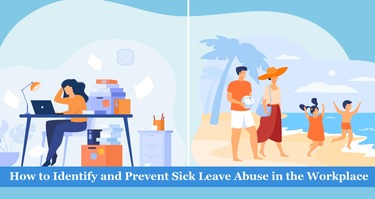
An organization’s sphere of relevance prevails around its employees and policies. Employees act as a primary driving force of the firm, while on the other hand, policies act as a foundation of the organization. The codependent relationship employees and organizations share is pretty evident. Yet, there are certain drawbacks in the working system due to which the validation of the policies and codependent bond diminishes. The pact of loyalty and codependent link always stays on the stakes. Employers are the key medium who communicate on behalf of the organization to their respective employees. Employers act as a bidirectional channel that encompasses messages for both parties.
What is Leave Abuse?
Leave abuse means taking advantage of prevailing regulations and falsifying them, claiming accountability. Such misuse raises a concern of misconduct in the organization. Leave abuse is misconduct, too, which isn’t addressed attentively due to certain loopholes in the system. Prominent firms chose to pave rigid working systems to eliminate such loopholes and work efficiently. Yet compliance with regulations suggested by federal authorities sometimes backfires on the organizations.
The most commonly exploited leave abuse is sick leave abuse. Under which an employee takes leave by justifying their non-genuine health concerns as a base of leaves. After meeting certain parameters, employees are qualified to have the right to opt for prominent leaves. And it’s not like the system doesn’t allow employees with certain leaves and holidays even though such disregardful attitude of employees toward their respective organizations raises a lot of concern.
Leave abuse occurs when an employee of any particular organization chooses to opt for leave by giving false reasons as a justification. The basis of leave abuse is that employees use general terms and notions as a shield for their means. Using certain federal suggested policies or organizations’ regulatory norms for personal reasons is the foundation of exploitation here.
Under federal suggestion, many occasional leaves have been granted to employees under federal jurisdiction. When an employee takes leave in case of medical insurgencies, FMLA applies. After satisfying the suggested parameters, an employee becomes eligible to ask for FMLA-regulated leaves. FMLA allows eligible paid employees to take leave in case of medical emergencies or family medical emergencies like pregnancy leave or case of spouse sickness. FMLA allows employees to take intermittent leaves and reduces the leave schedule to eligible employees or in severe need of so. Just like FMLA, certain federal regulations like ADA and workers’ compensation also provide employees reliable assistance in matters of leave. Yet some employees who misuse these regulations damage the representative image of employees in the name of a few.
Department of Labor provides numerous unpaid leaves for dutiful occasions. Occasional leaves like sick leave, jury duty, funeral leave, and personal leave. ADA and Worker’s compensation act in the same way as FMLA. Yet over some time, certain laws have been disregarded for granted.
Determining the eligibility for leave under FMLA, ADA, and Worker’s Compensation
FMLA allows employees to take job-protected, unpaid leave for up to 12 working weeks. Yet not every employee does have the privilege of getting left based on FMLA. To get leave under FMLA, employees must have worked for more than 12 months in any particular organization. To be more precise, the employee must’ve covered the criteria of aggregately working more than 1,250 hours in 12 months. And the employers must have recruited more than 50 employees working under the jurisdiction of 75 miles.
ADA enables employees to extend their leaves in case of long-prevailing injuries or recovery periods from surgeries or accidents. Reasonable accommodations highlight that certain amendments or adjustments would be made for some employees so that workforce doesn’t get disrupted. The eligibility to justify leave under ADA requires an evident set of proofs from the employee’s end. Leave or extended leave could be categorized as a reasonable accommodation under ADA. While on the other hand, Worker’s compensation allows employees to get fair compensation or financial or insurance-based assistance from the firm on behalf of the organization in case of on-duty injuries. With assistance from the organization’s end, several adjustments and compensatory gestures from the employees are included.
Few Examples of possible Leave Abuse
Before starting a few examples, let us be clear on the note that leave abuse doesn’t include any physical violence. It is a situation in which manipulation occurs from the employee’s end.
Suppose an employee has used all her FMLA leaves, and now her request for vacation leave is declined. Yet she proceeds to take leave as per her wish and present unreliable medical certifications as a part of an excuse to get a bailout of the situation. This situation would be counted as a possible leave abuse, where an employee has already taken their FMLA rights and is taking leave and presenting medical documents as an excuse.
Suppose an employee requests their employer for intermittent leave, specifically on Mondays and Fridays, without any evident medical subscription or document proving the severity of the employee’s situation. Creating hoax scenarios to manipulate the employers and organizations. This situation could also be counted as a possible case of leave abuse.
The Intersection of Federal Laws
FMLA, ADA, and Worker’s Compensation are different federal laws that provide reliable assistance to employees in case of leave benefits and compensation distribution. Yet the relevance of these laws is quite correlational.
For instance, if an employee has exhausted his FMLA leaves and requires leaves due to medical uncertainty. Then the employee could get access to leave per the ADA’s reasonable accommodation or get compensatory assistance from the respective organization according to the Worker’s compensation law. In case of exhaustion of leaves under each of three laws, employers can seek to terminate the employee if the pact of adjustments is getting quite often for them.
Tips for Employers to deal with Leave Abuse
Following are some suggestive measures that the employers could adopt to curb the situation of leave abuse:
- Employers can amend or modify major organization policies to curb the situation like leave abuse. Modifying policies like absenteeism, sick leave, attendance, and job abandonment. Modifying such policies according to the prevailing leave abuse in certain organizations would help a lot.
- Paving a structure of systematic and rigid questioning from employees about the leave request. To ensure the legitimacy of leave requests, an employer can seek to put up the pact of strict questioning. And requiring a proper form of documentation specifying the concern and reason behind leave requests. It would help in maintaining an intact record of leave requests.
- Establishing and implementing company call-in procedures. It would help in curbing the situations when employees take unscheduled leave. And asking employees to provide clear medical justification or other proof as to the justification for taking unscheduled leave.
- Requesting recertification and second or third party opinion from the concerning sources regarding an employee leave. It would help in having assured clarification regarding any employee leave request.
- In severe cases, employees seem to lie about their leave requests. Surveillance and investigation are also an option. If an employer is doubtful about such a situation, they can opt for such options.




